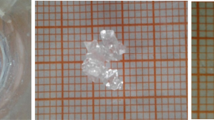Abstract
Ranitidine is in a class of medications called H2 blockers. It decreases the amount of acid made in the stomach. It is commonly used in treatment of peptic ulcer disease (PUD) and gastro-esophageal reflux disease (GERD). In this study, the ranitidine’s tautomers stability, structural data, HOMO, LUMO orbitals (energies and shapes), ΔΕ HOMO–LUMO gaps, UV–visible data and graphs, dipole moments, Mulliken charges, thermodynamic and kinetic stabilities in aqueous media as a biological solvent, and some of the different media (vacuum, H2O, Et-OH and DMSO) were investigated for tautomers of ranitidine by the density functional theory (DFT) B3LYP/6-31G** method.












Similar content being viewed by others
References
Kahrilas JP (2008) N Engl J Med 359(16):1700–1707
Khan M, Santana J, Donnellan C, Preston C, Moayyedi P (2007) Cochrane Database Syst Rev 18(2):CD003244
Jakob SM, Parviainen I, Ruokonen E et al (2005) Acta Anaesthesiol Scand 49(3):390–396
Salom IL, Silvis SE, Doscherholmen A (1982) Scand J Gastroenterol 17(1):129–131
Mitchell SL, Rockwood K (2001) J Clin Epidemiol 54(5):531–534
Hardman JG, Petri AW (1996) Goodman and Gilman’s, the pharmacological basis of therapeutics, 9th edn. McGraw-Hill, New York, pp 1092–1094
Pali-Schöll I, Jensen-Jarolim E (2011) Allergy 66(4):469–477
Mallow S, Rebuck JA, Osler T et al (2004) Curr Surg 61(5):452–458
Canani RB, Cirillo P, Roggero P et al (2006) Pediatrics 117(5):817–820
Cobelens FGJ, Leentvarr-Kuijpers A, Kleijnen J, Coutinho RA (1998) Trop Med Intern Health 3:896–903
Neal KR, Briji SO, Slack RCB et al (1994) Br Med J 308:176
Neal KR, Scott HM, Slack RC, Logan RF (1996) BMJ 312:414–415
Wickramasinghe LSP, Basu SK (1984) Br Med J 289(6454):1272
Ruddell WS, Axon AT, Findlay JM et al (1980) Lancet I:672–674
Untersmayr E, Bakos N, Scholl I et al (2005) FASEB J 19(6):656–658
Lednicer D (ed) (1993) Chronicles of drug discovery, vol 3. ACS Professional Reference Books, Washington, pp 45–81
Bradshaw J, Clitherow JW, Price BJ (1978) Aminoalkyl furan derivatives. US patent 4128,658, 5 Dec. 1978
Targema M, Obi-Egbedi NO, Adeoye MD (2013) Comput Theor Chem 1012:47–53
Shaji S, Eappen SM, Rasheed TMA, Nair KPR (2004) Spectrochem Acta Part 60:351–355
Islam MM, Bhiuyan MDH, Bredow T, Try AC (2011) Comput Theor Chem 967:165–170
Kosar B, Albayrak C, Ersanli CC, Odabasoglu M, Buyukgungor O (2012) Spectrochim Acta 93:1–9
Praveen PL, Ojha DP (2012) Cryst Res Technol 47:91–100
Anbarasan PM, Kumar PS, Geetha M, Govindan R, Manimegalai S, Velmurugan K (2010) Rec Res Sci Tech 2:8–16
Sundaraganesan N, Karpagam J, Sebastian S, Conard JP (2009) Spectrochem Acta 73:11–19
Karakas A, Unver H (2010) Spectrochim Acta 75:1492–1496
Y. Shao, L. Fusti-Molnar, Y. Jung, J. Kussmann, C. Ochsenfeld, S.T. Brown, A.T.B. Gilbert, L.V. Slipchenko, S.V. Levchenko, D.P. O’Neill, R.A. DiStasio Jr., R.C. Lochan, T. Wang, G.J.O. Beran, N.A. Besley, J.M. Herbert, C.Y. Lin, T. Van Voorhis, S.H. Chien, A. Sodt, R.P. Steele, V.A. Rassolov, P.E. Maslen, P.P. Korambath, R.D. Adamson, B. Austin, J. Baker, E.F.C. Byrd, H Dachsel, R.J. Doerksen, A. Dreuw, B.D. Dunietz, A.D. Dutoi, T.R. Furlani, S.R. Gwaltney, A. Heyden, S. Hirata, C.-P. Hsu, G. Kedziora, R.Z. Khalliulin, P. Klunzinger, A.M. Lee, M.S. Lee, W. Liang, I. Lotan, N. Nair, B. Peters, E.I. Proynov, P.A. Pieniazek, Y.M. Rhee, J. Ritchie, E. Rosta, C.D. Sherrill, A.C. Simmonett, J.E. Subotnik, H.L. Woodcock III, W. Zhang, A.T. Bell, A.K. Chakraborty, D.M. Chipman, F.J. Keil, A. Warshel, W.J. Hehre, H.F. Schaefer III, J. Kong, A.I. Krylov, P.M.W. Gill, M. Headgordon, B.J. Deppmeier, A.J. Driessen, T.S. Hehre, J.A. Johnson, P.E. Klunzinger, J.M. Leonard, I.N. Pham, W.J. Pietro, J. Yu, SPARTAN’10, build 1.0.1, (Wavefunction Inc., Irvine CA, 2011)
Dufert A, Werz DB (2008) J Org Chem 73:5514–5519
Kavitha E, Sundaraganesan N, Sebastian S (2010) Indian J Pure Appl Phys 48:20–30
Ramachandran KI, Deepa G, Namboori K (2008) Computational chemistry and molecular modelling: principles and applications. Springer-Verlag, Berlin Heidelberg
Budyka MF, Zyubina TS, Zarkadis AK (2002) J Mol Struct 594:113–125
Lee YO, Pradhan T, No K, Kim JS (2012) Tetrahedron 68:1704–1711
Amalanathan M, Joe IH, Rastogi VK (2011) J Mol Struct 985:48–56
Dorsett H, White A (2000) Overview of molecular modelling and ab initio molecular orbital methods suitable for use with energetic materials: a review. DSTO Aeronautical and Maritime Research Laboratory, Australia
Atkins PW, Friedman RS (2004) Molecular quantum mechanics, 4th edn. Oxford University Press, New York
Grossmann B, Heinze J, Moll T, Palivan C, Ivan S, Gescheidt G (2004) J Phys Chem 108:4669–4672
Gece G (2008) Corros Sci 50:2981–2992
Atkins P, de Paula J (2006) Physical chemistry, 8th edn. Oxford University Press, New York
Mortimer RG (2008) Physical chemistry, 3rd edn. Elsevier Inc., USA
Parimala K, Balachandran V (2011) Spectrochim Acta 81(1):711–723
http://en.wikipedia.org/w/index.php?title=Mulliken_population_analysis&oldid=572345005
Mulliken RS (1955) J Chem Phys 23(10):1833–1840
Leach AR (2011) Molecular modelling: principles and applications. Prentice Hall, Englewood Cliffs
Schlik T (2013) Molecular modeling and simulation: an interdisciplinary guide (Interdisciplinary applied mathematics), 2nd edn. Springer, Heidelberg
Ohlinger WS, Philip KE, Bernard JD, Warren JH (2009) J Phys Chem 113(10):2165–2175
Bickelhaupt FM, van Eikema Hommes NJR, Fonseca Guerra C, Baerends EJ (1996) Organometallics 15(13):2923–2931
Reed AE, Weinstock RB, Weinhold F (1985) J Chem Phys 83(2):735–746
Salve P, Gharge D, Kirtawade R, Dhabale P, Burade K (2010) Int J Pharm Tech Res 2(3):2071–2074
Mishra AN, Rana AC (2009) Int J Chem Sci 7(3):2208–2210
Dash SC, Das NN, Mohanty P (2011) Indian J Chem Tech 18:132–136
https://mc.usp.org/sites/default/files/documents/Ranitidine%20HCl%20Summary%20Validation%20Report-2013-04-12_0.pdf, and https://mc.usp.org/sites/default/files/documents/Ranitidine%20Injection%20Summary%20Validation%20Report-2013-05-31.pdf; USP-MC, Ranitidine Hydrochloride Summary Validation Report, 2013, Pages 1–34
http://www.gsk.ca/english/docs-pdf/product-monographs/Zantac.pdf
Acknowledgments
The corresponding author gratefully acknowledges Theoretical and Computational Research Center of Chemistry and Nano Sciences, Faculty of Chemistry, Razi University, Kermanshah, Iran.
Author information
Authors and Affiliations
Corresponding author
Rights and permissions
About this article
Cite this article
Taherpour, A.A., Mozafai, A., Ranjbar, S. et al. A study of the effects of solvent on structural and conformational properties of ranitidine tautomer forms by DFT method. Struct Chem 26, 517–529 (2015). https://doi.org/10.1007/s11224-014-0510-7
Received:
Accepted:
Published:
Issue Date:
DOI: https://doi.org/10.1007/s11224-014-0510-7




